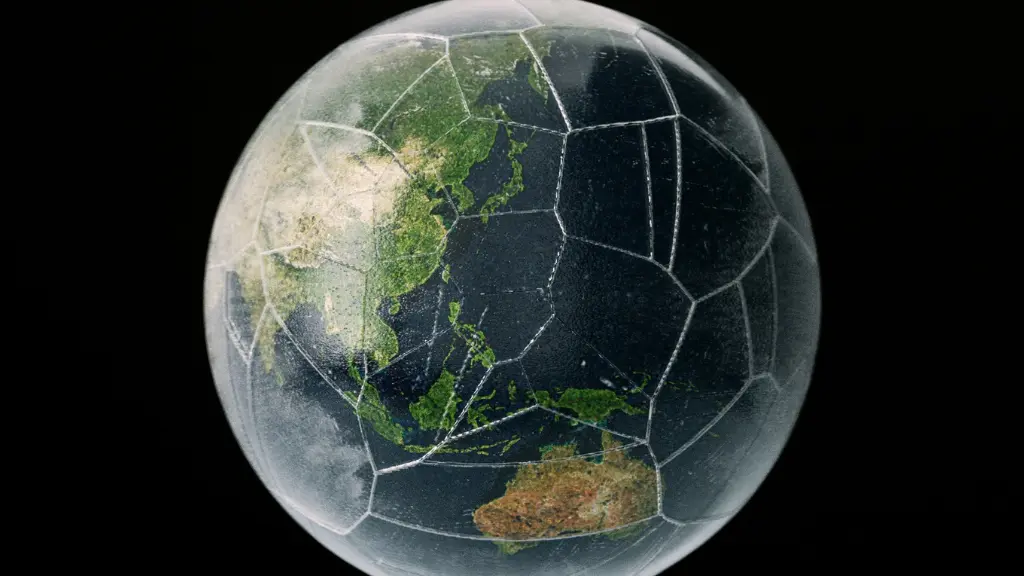

Jordens kärna är en fascinerande och mystisk del av vår planet. Som själva centrum för jordens kärna, spelar den en avgörande roll i planetens övergripande struktur och beteende. Kärnan består av två distinkta delar: den inre kärnan och den yttre kärnan.
Den inre kärnan är en solid sfär bestående av järn och nickel, med en diameter på cirka 1 200 kilometer. Den är omgiven av den yttre kärnan, som är ett lager av smält metall som är cirka 2 300 kilometer tjockt. Tillsammans utgör dessa två lager cirka 15% av jordens totala volym. Kärnan är också otroligt varm, med temperaturer som når upp till 6 000 grader Celsius i mitten.
Forskare har studerat jordens kärna i decennier, men det finns fortfarande mycket som är okänt. De senaste tekniska framstegen har dock gjort det möjligt för forskare att få en bättre förståelse för denna mystiska region. I den här artikeln kommer jag att utforska jordens kärna mer i detalj, inklusive dess sammansättning, beteende och vilken roll den spelar för att forma vår planet.

Jordens kärna är den centrala delen av vår planet, belägen under manteln och skorpan. Den är uppdelad i två lager: den fasta inre kärnan och den flytande yttre kärnan. Sammansättningen av jordens kärna är ett ämne av stort intresse för forskare, eftersom det hjälper oss att förstå bildningen och utvecklingen av vår planet.
Den kemiska sammansättningen av jordens kärna tros vara främst järn (Fe) och nickel (Ni). Dessa grundämnen utgör mer än 80% av kärnans massa, med mindre mängder andra grundämnen som svavel (S), syre (O) och kisel (Si). Den exakta sammansättningen av kärnan är svår att bestämma, eftersom det är omöjligt att direkt observera den. Men forskare har kunnat dra slutsatser om kärnans sammansättning baserat på seismiska data och experiment.
Jordens fasta inre kärna tros vara sammansatt mestadels av järn, med mindre mängder nickel och andra element. Den beräknas ha en radie på cirka 1 220 kilometer och en temperatur på cirka 5 000 grader Celsius. Trots sin höga temperatur förblir den inre kärnan solid på grund av det enorma trycket den är under.
Den flytande yttre kärnan av jordkärnan är också i första hand sammansatt av järn och nickel, men den innehåller också lättare grundämnen som svavel och syre. Den beräknas ha en tjocklek på cirka 2 300 kilometer och en temperatur på cirka 4 000 grader Celsius. Jordens magnetfält, som skyddar oss från farlig solstrålning, genereras av den yttre kärnan.
Sammanfattningsvis sammansättningen av jordens kärna består främst av järn och nickel, med mindre mängder av andra grundämnen. Den fasta inre kärnan och den flytande yttre kärnan spelar viktiga roller i jordens geologi och jordens magnetiska kärnfält. Ytterligare forskning behövs för att till fullo förstå sammansättningen och beteendet hos jordens kärna.

Som geofysiker har jag alltid varit fascinerad av dynamiken i jordens kärna. Kärnan är ett komplext system som består av två distinkta lager, den inre kärnan och den yttre kärnan. I det här avsnittet kommer jag att utforska rörelserna och värmeöverföringen i kärnan.
Jordens kärna är ständigt i rörelse. Kärnjordens magnetfält, som skyddar oss från farlig solstrålning, genereras av den yttre kärnan. Den yttre kärnans rörelse drivs av värmen som genereras från den inre kärnan och kylningen av den yttre kärnan i toppen. Denna rörelse är känd som konvektion.
Jordens rotation spelar också en nyckelroll i kärnans rörelse. Corioliseffekten gör att konvektionsströmmarna roterar medurs på norra halvklotet och moturs på södra halvklotet. Denna rotation skapar en dynamoeffekt, som genererar jordens magnetfält.
Den inre kärnan, å andra sidan, roterar oberoende av den yttre kärnan. Rotationen av den inre kärnan är något snabbare än rotationen av jordens yta, och fullbordar en hel rotation var 24:e timme. Denna rotation genererar en liten mängd energi, som tros vara ansvarig för att upprätthålla kärnans magnetfält.
Kärnan i geovetenskapen är extremt het, med temperaturer som stiger till så högt som 6 000 grader Celsius. Värmen genereras från sönderfallet av radioaktiva isotoper och restvärme från jordens formation. Värmen överförs sedan från den inre kärnan till den yttre kärnan genom ledning.
Kylningen av den yttre kärnan i toppen skapar en temperaturgradient, som driver konvektionsströmmarna. När det varma materialet stiger, kyls det och sjunker ner igen, vilket skapar en kontinuerlig cykel av värmeöverföring.
Sammanfattningsvis är dynamiken i jordens kärna ett komplext system av rörelser och värmeöverföring. Kärnans rörelser drivs av konvektion och jordens rotation, medan värmen genereras från sönderfallet av radioaktiva isotoper och restvärme från jordens formation. Att förstå dynamiken i kärnan är avgörande för att förstå jordens magnetfält och de processer som formar vår planet.

Som jordforskare tycker jag att studiet av jordens magnetfält är fascinerande. Magnetfältet är en viktig aspekt av vår planet och spelar en avgörande roll i vårt dagliga liv. I det här avsnittet kommer jag att diskutera vilken roll jordens kärna har för att generera och upprätthålla magnetfältet.
Jordens magnetfält uppstår från rörelsen av smält järn i den yttre kärnan. Den yttre kärnan är ett lager av flytande järn som omger den fasta inre kärnan. Det smälta järnets rörelse genererar elektriska strömmar, som i sin tur producerar magnetfältet.
Magnetfältet är inte statiskt, utan det förändras ständigt. De magnetiska polerna kan röra sig och till och med vända polariteten över tiden. Dessa förändringar beror på den komplexa dynamiken i jordens kärna och dess interaktioner med manteln och skorpan.
Geomagnetiska vändningar är de mest dramatiska förändringarna i jordens magnetfält. Under en vändning försvagas magnetfältet och magnetpolerna byter plats. Den senaste vändningen inträffade för cirka 780 000 år sedan, och forskare försöker fortfarande förstå mekanismerna som orsakar dessa vändningar.
En teori är att reverseringarna orsakas av förändringar i flödet av smält järn i den yttre kärnan. När flödet ändras försvagas magnetfältet och så småningom vänder det. En annan teori är att omkastningarna orsakas av interaktionerna mellan kärnan och manteln.
Sammanfattningsvis är jordkärnans magnetfält ett komplext och dynamiskt system som genereras och upprätthålls av rörelsen av smält järn i den yttre kärnan. Magnetfältet spelar en avgörande roll i vårt dagliga liv, från vägledande kompasser till att skydda oss från skadlig solstrålning. Att förstå kärnans roll i jordens magnetism är ett viktigt studieområde för jordforskare.

Som jordforskare tycker jag att studiet av jordens kärna är fascinerande. Jordens kärna är den innersta delen av vår planet, bestående av en fast inre kärna och en flytande yttre kärna. Kärnan utgör cirka 15% av jordens volym och 32% av dess massa. Trots dess betydelse är det en utmanande uppgift att studera jordens kärna på grund av dess otillgänglighet.
En av de primära metoderna som används för att studera jordkärnan är seismisk våganalys. Seismiska vågor är vågor av energi som färdas genom jordens inre, och de kan ge värdefull information om egenskaperna hos jordens kärna. Genom att analysera restiden och amplituderna för seismiska vågor kan forskare sluta sig till densiteten, temperaturen och sammansättningen av jordens kärna.
En annan metod som används för att studera jordens kärna är beräkningssimulering. Detta innebär att man använder datormodeller för att simulera beteendet hos jordens kärna under olika förhållanden. Genom att variera parametrar som temperatur, tryck och sammansättning kan forskare få insikter om dynamiken i jordens kärna och hur den påverkar jordens magnetfält.
Sammanfattningsvis är att studera jordens kärna en komplex och utmanande uppgift som kräver användning av flera metoder och tekniker. Genom seismisk våganalys och beräkningssimulering får forskare en bättre förståelse av jordens kärna och dess roll i att forma planeten vi lever på.

Som någon som har studerat jordens kärna kan jag med säkerhet säga att kärnan är en av de mest fascinerande och viktiga delarna av vår planet. Den är belägen i jordens centrum och består av två kärnor i jordlager: den inre kärnan och den yttre kärnan.
Gränsen mellan jordkärnan och manteln är känd som gränsen mellan kärnan och manteln. Den ligger cirka 2 900 kilometer under jordens yta. Gränsen markeras av en kraftig ökning av densiteten och en förändring i beteendet hos seismiska vågor som passerar genom den.
Kärn-mantelgränsen är ett mycket viktigt studieområde för geologer och seismologer. Man tror att gränsen spelar en avgörande roll i rörelsen av tektoniska plattor och bildandet av vulkanisk aktivitet. Gränsen tros också vara ansvarig för att generera jordens magnetfält.
Interaktionerna mellan kärnan och skorpan är också mycket viktiga. Jordens kärnvärme driver rörelsen av tektoniska plattor, som i sin tur formar jordens yta. Kärnan spelar också en roll i bildandet av berg, eftersom rörelsen av tektoniska plattor kan göra att skorpan bucklas och vikas.
Dessutom är jordens kärnmagnetiska fält ansvarigt för att skydda jorden från de skadliga effekterna av solvind och kosmisk strålning. Utan detta magnetfält skulle livet på jorden vara mycket svårare, för att inte säga omöjligt.
Sammantaget är jordens kärna en avgörande del av jordens inre. Dess interaktioner med manteln och skorpan är ansvariga för många av de geologiska processer som formar vår planet. Genom fortsatta studier och forskning kan vi få en bättre förståelse för kärnan och dess roll i vår planets historia och framtid.

Som någon som har studerat kärnan i planeten jordens kärna kan jag med tillförsikt säga att den har ett betydande inflytande på ytfenomen. I det här avsnittet kommer jag att diskutera två viktiga sätt på vilka kärnan påverkar jordens yta: vulkanisk aktivitet och tektoniska rörelser.
Jordens kärna spelar en avgörande roll i genereringen av vulkanisk aktivitet. Magma, som är smält sten som finns under jordens yta, skapas genom smältning av stenar i manteln och skorpan. Denna smältning orsakas av de höga temperaturer och tryck som finns djupt inne i jorden, som i slutändan genereras av värmen som frigörs av kärnan.
Jordens kärna påverkar också sammansättningen av magma. Kärnan består huvudsakligen av järn och nickel, och dessa grundämnen tros vara källan till det järn och nickel som finns i magma. Dessutom kan kärnans magnetfält påverka rörelsen av magma, vilket i sin tur kan påverka platsen och intensiteten av vulkanutbrott.
Jordens kärna spelar också en betydande roll i tektoniska rörelser, som är rörelserna för jordens skorpplattor. Kärnans värme tros vara den primära drivkraften för dessa rörelser, eftersom den orsakar konvektionsströmmar i manteln. Dessa strömmar driver i sin tur rörelsen av jordskorpans plattor.
Jordkärnan påverkar också jordskorpplattornas sammansättning och styrka. Värmen som alstras av kärnan gör att stenarna i manteln och skorpan blir mer duktila, vilket gör att de lättare deformeras. Detta kan leda till att det bildas förkastningar och sprickor i jordskorpan, vilket i slutändan kan leda till jordbävningar.
Sammanfattningsvis har jordens kärna ett betydande inflytande på ytfenomen, särskilt vulkanisk aktivitet och tektoniska rörelser. Att förstå kärnans roll i dessa processer är avgörande för att förutsäga och mildra effekterna av naturkatastrofer som vulkanutbrott och jordbävningar.

Som geolog tycker jag att jordens kärna är ett fascinerande ämne. Det påverkar inte bara planetens magnetfält utan har också en inverkan på haven. I det här avsnittet kommer jag att diskutera förhållandet mellan jordens kärna och haven.
Jordkärnan genererar värme, som överförs till ytan genom konvektion. Denna värme driver den termohalina cirkulationen, som är ansvarig för vattnets rörelse i haven. Den termohalina cirkulationen drivs av skillnader i temperatur och salthalt, vilket skapar densitetsgradienter i havet.
Det varma vattnet från ekvatorn strömmar mot polerna, där det svalnar och sjunker till havets botten. Detta kalla vatten rinner sedan tillbaka mot ekvatorn och fullbordar cirkulationen. Denna process spelar en avgörande roll för att reglera jordens kärnklimat genom att distribuera värme runt planeten.
Jordens kärna har också inverkan på havsnivåförändringar. Månens och solens gravitationskraft orsakar tidvatten, som kan påverkas av förändringar i jordens magnetfält. Magnetfältet genereras av rörelsen av smält järn i jordkärnan, vilket kan påverkas av yttre faktorer som solstormar.
Förändringar i havsnivån kan också orsakas av smältning av glaciärer och inlandsisar, som påverkas av jordens kärna. Issmältningen kan orsaka förändringar i massfördelningen på jordens kärnyta, vilket kan påverka planetens rotation och gravitationsfält.
Sammanfattningsvis spelar jordens kärna en betydande roll för havens funktion. Den termohalina cirkulationen och havsnivåförändringarna är bara två exempel på det komplexa förhållandet mellan jordens kärna och haven. Som geolog tycker jag att detta förhållande är ett fascinerande ämne för vidare studier.

Som forskare inom jordens kärnvetenskap är jag exalterad över de framtida möjligheterna för utforskning och upptäckt. Det finns fortfarande så mycket vi inte vet om vår planets inre funktion, och jag tror att fortsatt forskning och utforskning kommer att leda till nya insikter och en djupare förståelse av jordens kärna.
Ett område av särskilt intresse är studiet av seismiska vågor. Genom att analysera hur seismiska vågor färdas genom jordkärnan kan vi få värdefull information om kärnans sammansättning och struktur. Pågående forskning inom detta område kan leda till nya upptäckter om kärnans egenskaper och de processer som äger rum inom den.
En annan lovande väg för framtida forskning är användningen av datormodellering och simulering. Genom att skapa detaljerade modeller av jordens kärna kan vi simulera beteendet hos olika material och testa olika hypoteser om kärnprocesser. Detta tillvägagångssätt har redan gett spännande resultat och jag tror att fortsatta investeringar inom detta område kommer att leda till ännu fler genombrott.
Dessutom tror jag att det fortfarande finns mycket att lära av direkt utforskning av jordens kärna. Även om detta är en skrämmande uppgift, dyker det upp nya tekniker och tekniker som kan göra det möjligt. Till exempel kan utvecklingen av avancerade borrtekniker och material tillåta oss att tränga djupare in i jordskorpan och nå kärnan. På liknande sätt kan framsteg inom robotik och fjärranalys göra det möjligt för oss att utforska kärnan utan att fysiskt gå in i den.

Sammantaget är jag optimistisk om framtiden Jordens kärna vetenskap och potentialen för nya upptäckter och insikter. Genom att fortsätta investera i forskning och utforskning kan vi fördjupa vår förståelse för vår planet och de krafter som formar den. Se fler liknande artiklar genom att klicka här: Cole Parmer Antilia: En detaljerad recension.